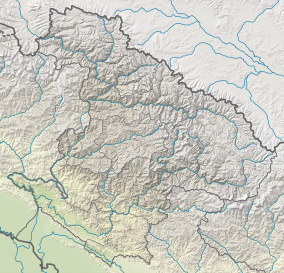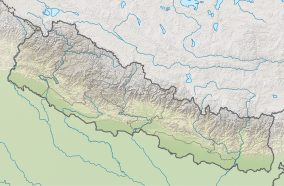|
Rara National Park
  Rara National Park is a protected area in the Himalayas of Nepal and was established in 1976. Covering an area of 106 km2 (41 sq mi) in the Mugu and Jumla districts, it is the country's smallest national park.[1] Its main feature is Rara Lake at an altitude of 2,990 m (9,810 ft).[2] The park was established to protect the unique flora and fauna of the Humla–Jumla Region of Nepal. The park ranges in elevation from 2,800 m (9,200 ft) to 4,039 m (13,251 ft) at Chuchemara Peak on the southern side of Rara Lake. On the northern side, the peaks of Ruma Kand and Malika Kand frame the alpine freshwater lake, which is the largest lake in Nepal with a surface of 10.8 km2 (4.2 sq mi) and a maximum depth of 167 m (548 ft). It is oval-shaped with an east–west axis, a length of 5 km (3.1 mi) and a width of 3 km (1.9 mi) draining into the Mugu-Karnali River via Nijar Khola.[2] Rara National Park is managed by the Department of National Parks and Wildlife Conservation and protected with the assistance of the Nepal Army. ClimateThe climate of Rara National Park is pleasant during the summer, but becomes very cold during the winter, because of the altitude. The best times to visit the park are in September, October, April, and May. During the winter, temperatures drop below freezing, and many high passes become blocked by snow.[3] The summer is warm, but June to August is monsoon season, making the trek to Rara National Park difficult.[4] VegetationRara National Park is rich in flora and fauna, with 1,070 plant species known to occur in the park. The vegetation is generally temperate and subalpine, and is dependent on the altitude.[2] Below 3,200 m (10,500 ft), the vegetation consists of mainly blue pine (Pinus excelsa), rhododendron (Rhododendron arboretum), west Himalayan spruce, black juniper and Himalayan cypress. Above 3,200 metres (10,500 ft), the vegetation changes to a coniferous forest consisting of a mixture of fir, spruce and pine. Fauna51 species of mammals reside in the park including musk deer, Himalayan black bear, Indian leopard, jackal, Himalayan tahr, yellow-throated marten, otter, dhole, gray langur, rhesus macaque, and red panda.[2] There are 241 recorded species of birds, including 49 wetland species. Coots are often found in the lake. During the winter, great-crested and black-necked grebes, red-crested pochards, mallard, common teal (Anas crecca), and common merganser are common. Other birds seen often include the Himalayan snowcock, chukar partridge, Himalayan monal, kalij pheasant and blood pheasant.[2] In 1979, three endemic snowtrout species were collected in Lake Rara and described as new species: the Nepalese snowtrout Schizothorax nepalensis, the Rara snowtrout, and Nepalese snowtrout.[5] Also in 1979, the frog species Paa rarica has been first recorded as endemic to the lake.[6] TourismGORP founder Bill Greer described Rara Lake as:
Another travel writer describes a trek in the park:
Environmental issuesDue to over-grazing and defecation, the national park conservation officers are facing a challenge to preserve the lake. Local people are found cutting timber wood and fuel wood, which is a problem for conservation of Rara. Also during festivals visitors and local people produce a lot of wastage causing water pollution.[8] Transport Even though the park does not have connection to the national road network, there are two ways to reach Rara National Park- airways and roadways. Roadways, it takes four days to reach Rara National Park from Kathmandu through the Karnali Highway and takes up to three days from the nearest town Jumla through means of trekking. From, Nepalgunj there is two ways to reach the lake, one is by following the salt route to Humla and another following a number of trails through Dolpo region. Through air, the nearest airport to the Rara National Park is Talcha Airport in Mugu and Jumla Airport in Jumla. There is no direct air service from Kathmandu to Mugu. Talcha can be reached from air only by getting down from Kathmandu to Nepalgunj or Surkhet. Rara National Park is mainly served by Talcha Airport, which is 4 km east of the lake. Nepal Airlines, Sita Air, Summit Air, and Tara Air operate flights to both Talcha Airport and Jumla Airport from Nepalgunj Airport. It takes approx. 3 hours to reach Rara National Park from Talcha Airport on foot.[9] Apart from this, a public bus also runs from Surkhet to Mugu headquarter Gamgadhi.[10] References
External links |
||||||||||||||||||||


